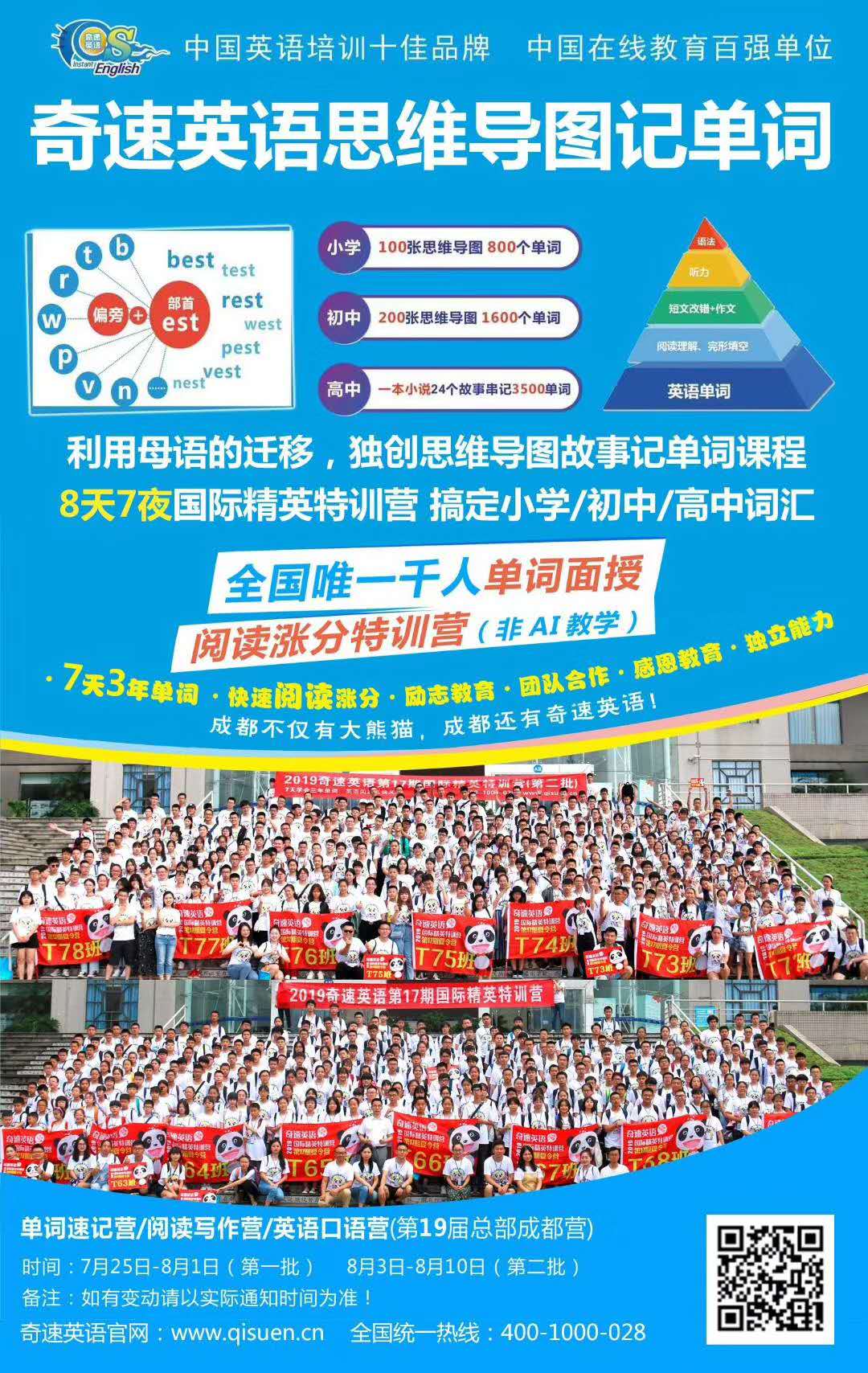-
2020-07-20
-
高中英语人教版备考复习必修2 Unit 5重难点汇总同步检测
2020-07-20
-
浙江温州小升初英语夏令营教学方式,有学奇速英语的吗?过来人告诉你答案!
2020-07-20
-
高中英语人教版备考复习必修2 Unit 4重难点汇总同步检测
2020-07-20
-
初中英语人教版八年级上册Unit 1英语写作指导及演练(含范文)
2020-07-20
更新时间:2020-07-20浏览:次评论: 条
2020-07-20
高中英语人教版备考复习必修2 Unit 5重难点汇总同步检测
2020-07-20
浙江温州小升初英语夏令营教学方式,有学奇速英语的吗?过来人告诉你答案!
2020-07-20
高中英语人教版备考复习必修2 Unit 4重难点汇总同步检测
2020-07-20
初中英语人教版八年级上册Unit 1英语写作指导及演练(含范文)
2020-07-20
name ['neim] n.名字;名称
nice ['nais] adj.令人愉快的;宜人的
to [tu:, tu, tə] 常用于原形动词之前,表示该动词为不定式
meet [mi:t] v.遇见;相逢
too [tu:] adv.也;又;太
your [jɔ:] pron.你的;你们的
Ms. n.(不指名婚否)女士
his [his] pron.他的
and [ænd, ənd] conj.和;又;而
her [hə:, hə] pron.她的
yes [jes] interj.是的;可以
she [ʃi:, ʃi] pron.她
he [hi:] pron.他
no [nəu] interj.不;没有;不是
not [nɔt] adv.不;没有
zero ['ziərəu] num.零
one [wʌn] num.一
two [tu:] num.二
three [θri:] num.三
four [fɔ:] num.四
five [faiv] num.五
six [siks] num.六
seven ['seven] num.七
eight [eit] num.八
nine [nain] num.九
telephone ['telifəun] n.电话;电话机
number ['nʌmbə] n.号码;数字
phone [fəun] n.电话
telephone/phone number 电话号码
first [fə:st] adj.第一
first name n.名字
last [lɑ:st] adj.最后的;末尾的
last name 姓
friend [frend] n.朋友
China ['tʃainə] 中国
middle ['midl] adj.中间的 n.中间
school [sku:l] n.学校
middle school 中学;初中
Gina 吉娜(女名)
Jenny ['dʒeni, 'dʒini] 珍妮(女名)
Brown [braun] 布朗(姓)
Alan ['ælən] 艾伦(男名)
Tom [tɔm] 汤姆(男名)
Mike [maik] 迈克(男名)
Jack [dʒæk] 杰克(男名)
Mary ['mɛəri] 玛丽(女名)
Miller ['milə] 米勒(姓)
Linda ['lində] 琳达(女名)
Jane [dʒein] 简(女名)
Green [gri:n] 格林(姓)
Smith [smiθ] 史密斯(姓)
【重点短语】
1. my name 我的名字
2. your name 你的名字
3. her name 她的名字.
4. his name 他的名字
5. I’m .. . 我是……
6. first name 名字
7. last name/family name 姓氏
8. Ms. Brown 布朗女士
9. your school ID card 你的学生卡
10. phone/telephone number 电话号码
11. his ID card number 他的身份证号码
12. my friend 我的朋友
13. nice to meet you 很高兴见到你
14. middle school 中学
15. in China 在中国
【重点句型】
1. — What’s your name? 你叫什么名字?
一I’m /M y name is Alan. 我叫艾伦。
2. — What’s his/h e r name? 他/她叫什名字?
--His /Her name is Eric /Mary .他/她叫埃里克/玛丽。
3. My friend is Eric Brown.
我朋友叫埃里克• 布朗。
4. My friend is in China.
我朋友在中国。
5. — What’s your last name? 你姓什么?
—-My last name is Green. 我姓格林。
6. — My name’s Jenny Green. 我的名字是珍妮• 格林。
—I’m Gina. Nice to meet you!我是吉娜。很高兴见到你
7. — What’s your telephone number?你的电话号码是多少?
—I t ’s 281-9176. 我的电话号码是281-9176
8. —Are you Helen? 你是海伦吗?
— Yes, I am. 是的,我是。
11. — Is he Jack? 他是杰克吗?
— Yes, he is. /N o,he isn’t. 是的,他是。/不,他不是。
1. parent,grandparent
parent 名词,“父亲或母亲”,指父母双亲之一。作主语时,谓语动词用单数形式;parents是parent的复数形式;意为“父母”,指两个人;作主语时谓语动词用复数形式。father(爸爸)和mother(妈妈)是具体的称谓;在口语中可以用mom和dad。例如:
Your parent is coming, don’t worry.
你的家长就要来了,不要担心。
Her parents are workers. 她的父母亲都是工人。
同样,grandparent指祖父母中的一个人,而grandparents指的是祖父母两个人。同样祖父母单独的具体称谓是grandfather(爷爷/姥爷)和grandmother(奶奶/姥姥);口语中也可以称grandpa和grandma。例如:
His grandparents live in the village.
他的祖父母住在那个小村庄里。
2. sister / brother
这两个词都是可数名词,复数是brothers / sisters;意为“姐姐,妹妹/哥哥,弟弟”。英语中需要表示长幼区别时通常在brother,sister前加上elder,表示“兄,姐”;加上little / younger表示“弟,妹”。例如:
This is my little sister Lily. 这是我的妹妹Lily。
It’s a photo of my elder brother. 这是一张我哥哥的照片。
3. these,those
these 是this的复数形式,意为“这些”。those是that的复数形式,意为“那些”。this与that后接单数名词;those与these后接复数名词。例如:
This is a book. 这是一本书。
Those are books. 那些是书。
4. uncle, aunt, cousin
此三词对应的汉语意思很广,可以通过上下文意思来判断,uncle可以指父亲或者母亲的兄弟,即“叔叔、伯伯和舅舅”,aunt指父亲或者母亲的姐妹,即“姑姑、婶婶和阿姨”。cousin 是他们的子女,即“堂(表)兄弟、堂(表)姐妹”。这三个词均为可数名词。例如:
My father’s brother is my uncle.
我爸爸的弟弟(哥哥)是我的叔叔(伯伯)。
My uncle’s son is my cousin.
我叔叔的儿子是我的堂兄弟。
5. family
family是名词,意为“家庭、家人”。当“家庭”讲时,是整体概念,谓语用单数;当“家人”讲时,是复数概念,谓语用复数。例如:
I have a big family. 我有一个大家庭。
My family are very kind. 我家人都很和蔼。
6. a photo of my family
a photo of my family的意思是“我的一张全家福照片”,相当于“my family photo”。of是表示名词所有格,是常用来表示无生命的名词所有格的形式, 表示所属关系;意为“……的……”。例如:
a map of China 一幅中国地图
the leg of the table 桌子的腿
【拓展】辨析:photo与 picture
两词都有“照片、相片”之意,都是可数名词,其复数都在词尾加-s,其区别如下:
photo 常指拍摄的“照片”。例如:
his is a photo of my brother. 这是我哥哥的一张照片。
picture不仅指“照片”,还可以指“图片、画像”。例如:
Can you draw a picture? 你能画一幅画吗?
7. and
and是并列连词,意为“和”。它可以连接两个或者两个以上并列的词、短语或者句子,有时不需要翻译出来,可以用来表示:
(1)并列关系 例如:
My mother and my father are both teachers.
我爸妈都是老师。
(2)承接关系 例如:
This is my book,and that’s your book.
这是我的书,那是你的书。
(3)强调反复、连续 例如:
They laughed and laughed.
他们笑了又笑。
8. have
have在本单元是动词,意为“经受,经历”,常用于一些固定搭配或者祝福语中。例如:
Have a good time! 玩的开心!
Have a good trip! 旅途愉快!
1.This/That is my friend Jane.
当我们把一个人介绍给另外一个人的时候,经常用这个句型,而不是用“He is…”或者“She is…”。例如:
-Mum, this is my teacher. 妈妈,这是我的老师。
-Miss Wang, this is my mother. 王老师,这是我妈妈。
此外,我们在指近处的物体时用“This is…”句型;指远处的物体时用“That is …”句型。例如:
This is my aunt. 这是我姑姑。
That is my friend. 那是我的朋友。
注意:“This is”不能像“What’s,I’m,It’s”那样缩写,但是 “That is”可以缩写成“That’s”。例如:
Look, that’s my friend, Bob. 看,那是我的朋友,鲍勃。
如果用来询问的时候,也可以用人称代词he或者she代替指示代词this/that。例如:
Is she your mother? 她是你的妈妈吗?
如果用指示代词this/that,在回答的时候用代词it。如果是人称代词询问,回答的时候用人称代词。例如:
-Is she your sister? 她是你的妹妹吗?
-Yes, she is. 是的,她是。
2. These/Those are my brothers.
本句子是“This is my brother.”的复数句,these和those是指示代词this和that的复数形式。句子变为复数的时候,指示代词、连系动词和后面的名词都要变为复数形式,不能只变后面的名词。例如: That is your bike. 那是你的自行车。
把这个句子变为复数句是:Those are your bikes. 那些是你们的自行车。
这种句型可用来介绍两个或者两个以上的人、物。this变为these;that变为those;is变为are;后面的名词用复数形式。例如:
Mum, these are my teachers. 妈妈,这些是我的老师们。
3. Who’s she/he?
Who是疑问代词,意为“谁;什么人”。用它可以构成特殊疑问句。句式是“Who + is + she/ he / it +?”,意为“……是谁?”。回答时用“He / She / It +is…”。
注意缩写的情况:who’s= who is she’s = she is he’s = he is it’s = it is 例如:
-Who’s she? 她是谁?
-She’s my aunt. 她是我姑姑/姨妈。
-Who’s he? 他是谁?
-He’s my uncle. 他是我叔叔/舅舅。
当我们需要对复数意义的词提问时,要用“Who are they?”来提问,意为“他们/她们/它们是谁?”;回答用“They are +…”。例如:
-Who are they? 她们是谁?
-They are my cousins. 她们是我的堂姐妹。
注意:当我们询问不确定身份的人时,要用代词“it”。例如:
-Who’s it in the picture? 照片里的人是谁?
-It’s my sister. 是我的姐姐。
4. Bring a photo of your family to class.
带一张你的全家福到班里来。
这是一个祈使句,祈使句是以动词原形开头,省略第二人称主语的句式。其否定式是在句首加Don’t。例如:
Open your book, please. 请打开书。
Don’t close the window. 不要关窗户。
“bring…to”是“把……带来”的意思。例如:
Bring your English book to my house, please.
请把你的英语书带到我家来。


长按识别二维码 咨询夏令营详情
本文整理于网络 版权归原作者所有
如有侵权请联系删除
暑期是提分黄金期。事实证明,很多学生因为暑假阶段放松自己,下学期开课差点全班垫底,不得不去辅导补习。而很多后进生反而在暑
发布时间:2020-07-14 浏览:155次 评论:条
《教育界》杂志奇速英语教育研究院互联网+英语学科深度融合课题招兼职研究员: 1.认可教育界及奇速英语理念 2.热爱英语教育教学
发布时间:2020-06-18 浏览:128次 评论:条
坊间流传: 出国留学找 新东方 英语口语找 疯狂英语 应试涨分研学找 奇速英语 奇速英语创始人 蔡章兵教授 奇速英语全国英语十佳
发布时间:2020-06-08 浏览:141次 评论:条
高考英语写作中,除了语法正确、表达准确地道,如果能再用一些较为高级的词汇,会让你的作文脱颖而出,获得评卷老师的青睐和喜爱
发布时间:2020-06-03 浏览:148次 评论:条